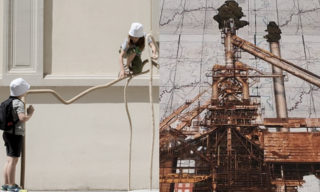In what ways can contemporary art help us understand history and offer answers to social issues that emerged in specific historical contexts? How can utopian visions of technology, in different geographies, be reactivated through contemporary art practices that relate to their surroundings? In his important book What Do Science, Technology and Innovation Mean from Africa?, MIT Clapperton Zimbabwean scholar Chakanetsa Mavhunga suggests that the meaning of technology is not universal, but rather assigned by societies, which employ it strategically to satisfy needs and desires in relation to a set of values. Similarly, it can be argued that art histories must be understood in relation to different constellations of aesthetic legacies and local understandings of art’s meaning and action. Artists Ibrahim Mahama (Ghana) and Temitayo Ogunbiyi (Nigeria/USA/Jamaica) will address these questions, in relation to their practice and to works recently produced at Madre with the support of the Fondazione Donnaregina per le arti contemporanee, during an online lecture titled Multiple histories of art and technology on Thursday, 25 February, at 6:30 pm. The discussion which will take place in English, is moderated by Madre’s Artistic Director Kathryn Weir. The event is realized in collaboration with Black History Month Florence, an inter-institutional network created in 2016 to promote black cultural production that celebrates Afro-descendant cultures in the Italian context.
Ogunbiyi’s installation currently on view at Madre Giocherai nel quotidiano,correndo/You will play the everyday, running, 2020, was commissioned in April 2020 by Weir and produced remotely between Lagos and Naples during the first Italian lockdown due to the Covid pandemic. She is currently producing an extension of the project in which a constellation of sculptural elements will become a musical instrument that can be played by the public. Says the artist, ‘I turned to music as a malleable technology and an undervalued relic of knowledge. I also wanted to respond to Miriam Makeba’s performance on 9 November, 2008 in Castel Volturno, which is not far from Naples. On 18 September of the same year, young people from Ghana, Libya, Togo and Liberia were massacred in this town. The great musician honored them with her last concert.’
The two large photographic collages Red Rivers and Garden of Eden by the renowned Ghanaian artist Ibrahim Mahama, which will be presented at the museum from March, were made during a residency last October-November. They relate the industrial history of the Italsider site in Bagnoli to Mahama’s larger project ‘Parliament of Ghosts’, which considers how the utopian promise of failed technologies and infrastructure of the past can be reactivated in the present. Mahama’s project in Naples, curated by Kathryn Weir and Gianluca Riccio, takes place as part of ‘Art-Ethics,’ a collaboration conceived in 2019 by Laura Valente (then president of Fondazione Donnaregina per le arti contemporanee) and Sebastiano Maffettone, director of the Ethos Observatory/Luiss Business School.

